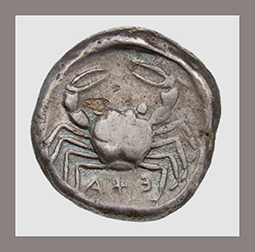Author: C. Devoto
Download article as .pdf: L’avvio della produzione monetale ad Agrigento. Qualche riflessione
 Il contributo affronta il tema dell’introduzione della moneta ad Agrigento nell’ottica di una lettura che tenga conto non solo dell’oggetto moneta nelle sue specificità tecniche, ponderali e iconografiche, ma anche del più ampio contesto storico e sociale in cui la prima coniazione agrigentina si colloca. Se da un lato alcune caratteristiche tecniche delle prime serie acragantine sembrano utili a determinare il loro modello di riferimento e il distretto commerciale cui esse erano in prima istanza destinate, dall’altra la produzione di metallo monetato sembra rispondere a dinamiche sociali ed economiche che affondano le loro radici nel periodo precedente alla tirannide di Terone, facendo della coniazione la tappa di un meccanismo già avviato.
Il contributo affronta il tema dell’introduzione della moneta ad Agrigento nell’ottica di una lettura che tenga conto non solo dell’oggetto moneta nelle sue specificità tecniche, ponderali e iconografiche, ma anche del più ampio contesto storico e sociale in cui la prima coniazione agrigentina si colloca. Se da un lato alcune caratteristiche tecniche delle prime serie acragantine sembrano utili a determinare il loro modello di riferimento e il distretto commerciale cui esse erano in prima istanza destinate, dall’altra la produzione di metallo monetato sembra rispondere a dinamiche sociali ed economiche che affondano le loro radici nel periodo precedente alla tirannide di Terone, facendo della coniazione la tappa di un meccanismo già avviato.
The paper tackles the topic of the introduction of coinage in Agrigentum (Akragas) from a perspective that takes into account the coin object in its technical specificities (weight, shape, coin types), but also considers the broader historical and social context in which the coin production began. On the one hand, certain technical characteristics of the earliest Acragantine series seem useful in determining their model and the commercial district which they were primarily intended for; on the other, the production of coinage seems to respond to the social and economic dynamics rooted in the period before to the tyranny of Theron. Thus, minting appears to be just another step in an already triggered mechanism.




